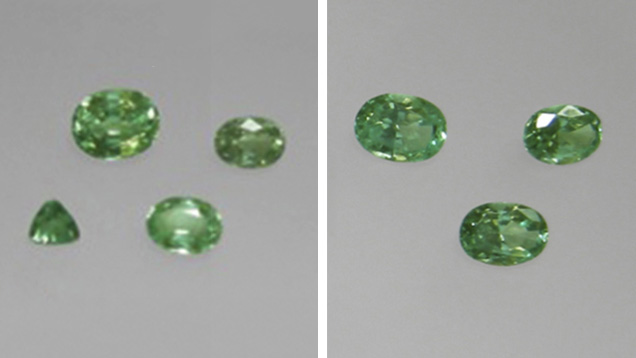Distinguishing Between Natural and Synthetic Green Chrysoberyl

Natural mint-green chrysoberyl, much of it extremely clean, is also found in Ilakaka, Madagascar; Sri Lanka; and Mogok, Myanmar. Prior to this study, there had been very little investigation into either natural or synthetic V-bearing chrysoberyl. The authors compare the optical characteristics and trace element composition of the Kyocera synthetic material with natural specimens from all four regions to help distinguish between the various sources. Additionally, they evaluate the impact of V3+, Cr3+, and Fe3+ on color and absorption characteristics.
The Kyocera synthetic chrysoberyl, most similar in appearance to the Tunduru material, almost exclusively contained the chromophore V3+ (approximately 0.1 wt.% V2O3), with little to no Ti4+, Cr3+, or Fe3+ present. Natural green chrysoberyl had much more variable amounts of these cations, with Tunduru specimens containing 0.04–0.30 wt.% V2O3, 0.004–0.040 wt.% Cr2O3, 0.001–0.110 wt.% TiO2, and 0.08- 0.32 wt.% Fe2O3. The Ilakaka material, some of which appeared more yellow than the Tunduru chrysoberyl, had similar levels of V2O3, was nearly Cr2O3 free, and had lower levels of TiO2. In some cases, the samples showed significantly more Fe2O3, with levels as high as 0.55 wt.%. Sri Lankan material, which was more yellowish green than the other studied samples, had substantially more Fe2O3 (0.47 – 0.90 wt.%), with generally less V2O3 and similar Cr2O3 contents as compared to Tunduru material. The Mogok chrysoberyl, which was an intense bluish green, had essentially no iron but high levels of both V2O3 and Cr2O3, at 0.38 and 0.24 wt.%, respectively. The Mogok material also demonstrates the strongest pleochroism, with observed colors ranging from grayish violet to yellowish green to intense blue-green. Additionally, gallium was detected in all of the natural chrysoberyl and none of the synthetics. Tin is also found in much of the natural green chrysoberyl but not in the synthetic form.
Spectroscopically, the positions of the absorption maxima and the intensity ratios for the V3+ absorption bands were found to be consistent between synthetic and natural material containing little to no Cr3+. Features attributable to Cr3+ and Fe3+ were detectable in the corresponding natural spectra. Finally, the authors show that with the proximity of the Cr3+ and V3+ bands in chrysoberyl, separate bands for the two cations are not visible. Instead, a shift of the ν1 band to shorter wavelengths was observed with increasing Cr3+ content. Visually, much of the material was inclusion free, but all natural samples contained growth patterns not observed in the Kyocera synthetics.



